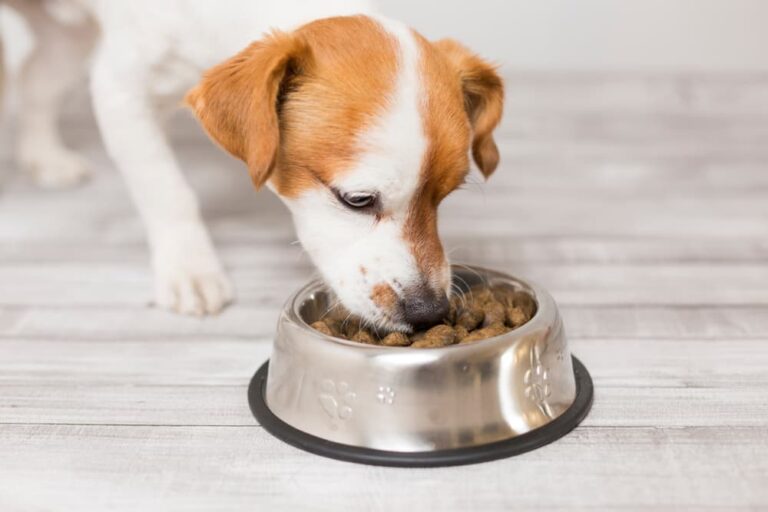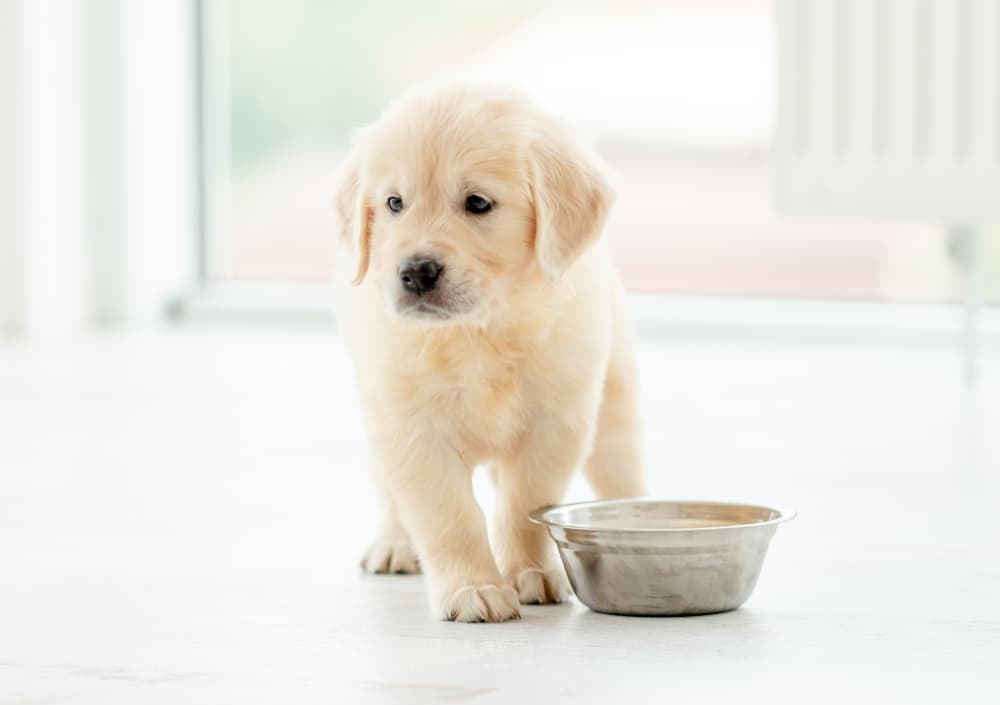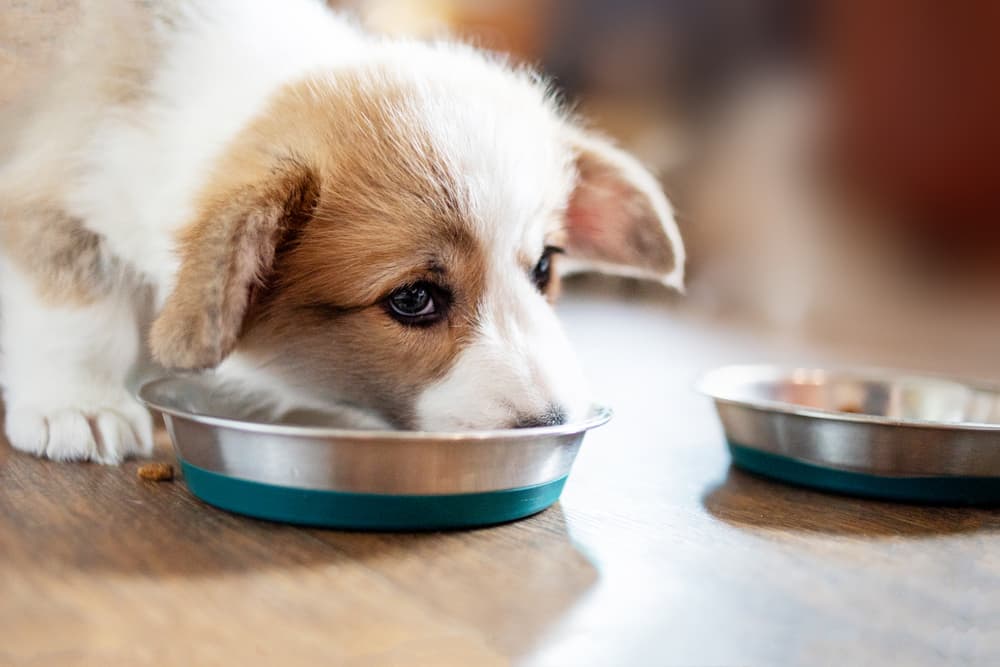Switching Dog Food: Tips and Recommendations

Overview
- There are a variety of reasons to switch dog food.
- Switching should happen gradually to prevent intestinal upset.
- Side effects of switching food too fast include diarrhea and vomiting.
- Planning and preparation can help make the transition to a new food easier.
Have you ever wondered how dogs can eat the same food every day? It turns out, dogs don’t really need variety in their food. Often “picky” dogs are the ones holding out for human food.
For all the canines readily eating their meals, as long as the food packaging has a label from the Association of American Feed Control Officials (AAFCO), the food is considered complete and balanced. If the food you feed daily is complete and balanced, you are giving your dog everything they need to live.
There are a few good reasons to consider switching dog food. If you need to make a diet change (due to a veterinary recommendation or a lifestyle change), following a diet transition timeline will help your dog adapt to the new ingredients, and may help prevent some unwanted consequences.
This article will help you understand reasons to switch dog food, how to switch diets, and what to do if you accidentally switch too fast. If you do need to make a change, you will be ready.
Switching Dog Food: Should You Do It?

There are a few situations in a dog’s life that may justify a food change.
These include:
- A transition from puppy food to dog food
- A transition from dog food to a senior dog food
- A transition from kibble to a canned version
- A transition to a veterinary-recommended prescription diet
Many pet owners will switch from a puppy-specific formula to an adult dog food formula as their puppies grow up. A food change may also be recommended when dogs enter the senior phase of their lives as nutrient and calorie needs change.
If your dog was born with a medical condition, or develops one during their life, a change in diet prescribed to address the condition may help your pet to feel better and even live longer. For instance, if your dog has digestive problems, your veterinarian may recommend switching to a dog food for sensitive stomachs.
When Switching Dog Food is Not Recommended
There are situations where changing a dog’s diet is not recommended. One such situation is switching a dog’s food to prevent food allergies. Currently, there is no evidence to support this concept.
Since food allergies develop because of a dog’s genes, and not because of the number of foods they have been exposed to, it is best to keep your dog on the one food they do well on and manage any allergies if/when they become prevalent in your dog’s life.
How to Switch Dog Food

A diet transition timeline varies from 10 days to three weeks in duration depending on the individual dog and their individual gut tolerance.
If your dog’s intestines can manage most foods, then a 10-day diet switch schedule is most appropriate. For more sensitive dogs, it’s best to take things nice and slow and use the longer transition schedule.
Short Dog Food Transition Timeline
| Day 1, 2 and 3 | 75% current food + 25% new food |
| Day 4, 5 and 6 | 50% current food + 50% new food |
| Day 7, 8 and 9 | 25% current food + 75% new food |
| Day 10 | 100% new food |
Long Dog Food Transition Timeline
| Week 1 | 75% current food + 25% new food |
| Week 2 | 50% current food + 50% new food |
| Week 3 | 25% current food + 75% new food |
| Week 4+ | 100% new food |
The percentages in the timelines above refer to the quantity of food fed. For example, if before the transition you were feeding 2 cups of the current food, then day 1 of the transition you would feed 75% of the current food which is 1½ cup. This leaves ½ cups of the new food to fill the bowl.
Regardless of which diet transition schedule is used, it is generally recommended to give your dog a pet-specific probiotic during the transition to help your dog’s stomach break down and digest the new ingredients in a healthy way. Consult your veterinarian to find the best probiotic that is recommended for your dog.
Side Effects of Switching Dog Food

If you didn’t take the time to follow a diet transition schedule, or if you otherwise tried to switch too quickly, you might get to see what intestinal upset looks like.
Consider a time when you have eaten a brand new cuisine or a food you were otherwise not used to eating. The stomach pain and/or bathroom consequences you experienced are similar to what a dog goes through after eating something their body is not used to. Intestinal upset can manifest as throwing up, little or no appetite, or diarrhea.
Diet-Switch Diarrhea and What to Do
For dogs, the most prevalent consequence of switching food too quickly is diarrhea.
When the intestines come in contact with new food suddenly, it can start secreting water into the intestines. Water mixed with these foreign ingredients can then quickly make their way toward your dog’s hind-end and you might see the following symptoms:
- Your dog showing an urgency to go to the bathroom
- Needing to go more frequently
- A softer or liquid stool quality
- Possibly even some blood in the stools
If you changed your dog’s food suddenly and now they have diarrhea, generally a bland diet is recommended.*
A bland diet recipe consists of approximately 50 percent white rice and 50 percent boiled, low-fat, boneless, skinless, seasonless chicken or turkey. The white rice helps to absorb the extra moisture in the intestines, while the bland protein provides an easy-to-digest energy source.
Along with a bland diet, a dog probiotic should be started and given for at least five days. Think of giving a probiotic like an antibiotic course, but instead of killing bacteria, we are simply providing the dog’s system with the bacteria that will help them digest food normally again.
Keep in mind that a bland diet is not meant to be a long-term solution. It does not provide all of the nutrients that a dog needs, so it shouldn’t be used for more than a few days. If your dog is having vomiting and diarrhea for more than 24-48 hours, he should see a vet.
*If your dog is less than 1 year of age and is having diarrhea for more than 6 hours, bring them to your veterinarian right away for care and rehydration.
Diet-Switch Vomiting and What to Do
In a small subset of cases, a dog fed a diet they are not used to may throw up (vomit).
As some of the abnormal food ingredients are sensed by the intestines and absorbed into the body, the brain may initiate a reflex that causes the stomach to push food back up towards the mouth in a forceful manner (retching). The process is complete when the food material is expelled from the body.
Your dog may throw up once or several times depending on what they have eaten and how sensitive they are.
If you changed your dog’s food suddenly and now they are vomiting, give them free access to water, but do not give them any food for a couple of hours** to let their stomach rest and recover.
After 2-4 hours, try giving a small amount, about ¼ of the current meal quantity, of their current (not new) food and see if they are interested and are able to keep the food down. If they do, you can then offer them the remainder of their meal.
**If your dog is less than 1 year of age and is vomiting, do not withhold food from them. If they continue to vomit for more than 6 hours, bring them to your veterinarian right away to help them stop vomiting and get rehydrated.
Diet-Switch Inappetence and What to Do
Eating less (inappetence) or not eating at all (anorexia) may result because of stomach upset or nausea when switching dog food. If you have started a diet transition and your dog is now eating less or not eating at all, it is generally recommended to follow the same guidelines as for if your dog is vomiting after eating a new food***.
Let their stomach rest for a few hours with free access to water. After the rest, try to offer them a small amount of food to see if they will eat it. If they do not, try again in a few hours.
***If your dog less than 1 year of age and is eating less than normal or not eating at all, do not withhold food from them and be sure they have free access to water. If they are not eating for more than 6 hours, bring them to your veterinarian right away for care.
When to Switch to Adult Dog Food

Depending on your dog’s breed and individual variation, puppies can become adults at different ages.
Smaller dogs become an adult at around 8 months of age; medium-sized dogs around 12 months of age; large dogs around 18 months of age; and giant-breed dogs, around 24 months of age.
When your dog becomes an adult, switching to an adult dog food is highly recommended. While some dogs may do well long-term on puppy or all-life-stages food, the extra calories in these diets can create problems with weight gain and obesity.
Note: Dog foods labeled “all life stages” have the energy content and composition of puppy food.
How to Pick an Adult Dog Food
Here are a few guidelines to help you choose an adult dog food when the time is right:
- To make the transition as smooth as possible, consider keeping the brand of adult food consistent with the brand of puppy food you were feeding.
- It is important that the food is “complete and balanced” so that your dog will receive all the vitamins, minerals, and nutrients they need in the correct proportions to support a functioning body.
- Make sure you are happy with the ingredients list. If you have any concerns, speak to your veterinarian.
- Be sure you are happy with the price tag. Since your dog will be on this long-term, make the food fits within your budget .
Once you have found the right food for your young adult dog, be sure to follow the diet transition schedule above to minimize stomach upset.
When to Switch to Senior Dog Food

A dog is more or less considered a senior at around 7-8 years of age. A senior dog food provides fewer calories to your dog during a given meal. The assumption behind the design of a senior diet is that, as dogs age, they are not as active as they once were and do not need the same number of calories as an active adult dog.
The problem with that assumption is that each dog is an individual whose energy, appetite, and metabolism are unique to that individual.
Here are a few guidelines to help you decide whether and when to switch your dog to a senior diet:
- If your senior dog is healthy, maintaining a healthy body weight: It is generally recommended to continue feeding your dog the adult food they know and love.
- If your senior dog is healthy but is gaining weight or overweight: A senior diet might be a good idea so you can meet your dog’s calorie needs without the extra weight and stress on their body.
- If your senior dog is seemingly healthy but unintentionally losing weight: Consider an exam with your veterinarian to figure out the cause of weight loss before making a decision about your dog’s diet.
- If your senior dog has a disease condition (diabetes, kidney disease, heart disease, etc.), there are many commercial and prescription diets you can feed to help manage those conditions.
How to Choose a Senior Dog Food
If you and your veterinarian decide that switching to a senior dog food is correct for your dog, choose a senior dog food with the guidelines below and follow the diet transition (switch) guidelines above according to their intestinal sensitivity.
Guidelines for choosing a senior dog food:
- Look for an AAFCO label stating that the food is complete and balanced
- Consider staying with the brand of food that has worked well in the past
- Consider a formula that includes joint support for arthritis
- Look for ingredients you feel comfortable feeding
- Find a senior dog food that fits within your budget
Switching to Grain-Free or Raw Dog Food

Some of the trendiest dog food diets on the market are grain-free diets and raw food diets. There are pros and cons to choosing either one. Before purchasing either, speak to your veterinarian about your intention to switch so they can guide you in your selection.
Grain-Free Diet Considerations
Pro: One possible reason for choosing a grain free dog food is a lower incidence of mycotoxins—chemicals created by fungi that can have negative effects on the body when consumed.
Con: Grain-free diets have lost popularity throughout 2019 after an FDA article made a loose connection between grain-free diets and the discovery of a heart condition called dilated cardiomyopathy (DCM). Unfortunately, we are unsure of the actual cause of the heart condition. This link needs to be investigated further.
As of early 2023, the investigation of the relation between diet and heart disease is still ongoing. There are many contributing factors to heart disease and dogs, including diet. Be sure to discuss your questions with your veterinarian, and seek the advice of a board certified nutritionist for further guidance.
Raw Diet Considerations
Pro: Raw diets are claimed to have superior digestibility to kibble and canned diets, increasing the nutrient absorption by the body. However, freshly-cooked diets also boast superior digestibility and are safer to have in your home and feed to your pet.
Cons: Remember that “raw” means little/no processing has been done to ensure your pet isn’t eating bad bacteria that can cause intestinal upset. Those bacteria can end up on you, your family members, and all over your home. Raw diets have been found to be nutrient deficient and on occasion, have sharp bone pieces that can do damage to the mouth or intestines. Raw diets may not be appropriate for immune compromised or unhealthy patients due to the bacteria content.
Switching Dog Food: Final Tips

If you choose to switch your dog’s food due to a lifestyle change, a recommendation from your veterinarian, or a budgetary need, there are some things you should keep in mind.
Follow these additional tips when changing your dog’s food:
Plan ahead. When a diet transition is needed or desired, planning ahead is important. Starting a diet transition a day or two before going out of town and leaving your dog with a sitter, or before bringing your dog on vacation is asking for trouble.
Have enough current food. Make sure you start the transition while you still have enough of the current food to last through the whole transition timeline.
Adjust the timeline if needed. If your dog has intestinal upset during a diet transition, start over and try a slower transition. The same transition speed will likely result in the same intestinal upset.
Observe your dog during and after the switch. After any diet transition, keep a close eye on your dog over the next several weeks. If they appear to be losing or gaining weight, alter the amount you are feeding by 5-10 percent and then watch them again.
Consult your veterinarian with questions. If you need help with your dog’s daily calorie intake, and how much you should feed, give your veterinarian a call—they know best.









